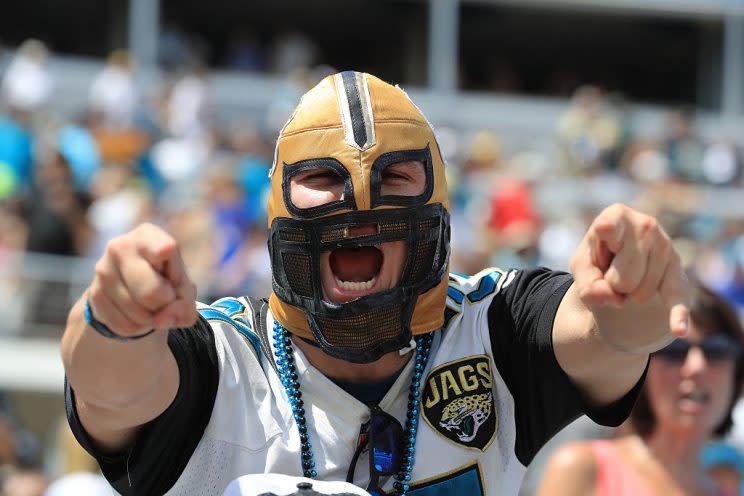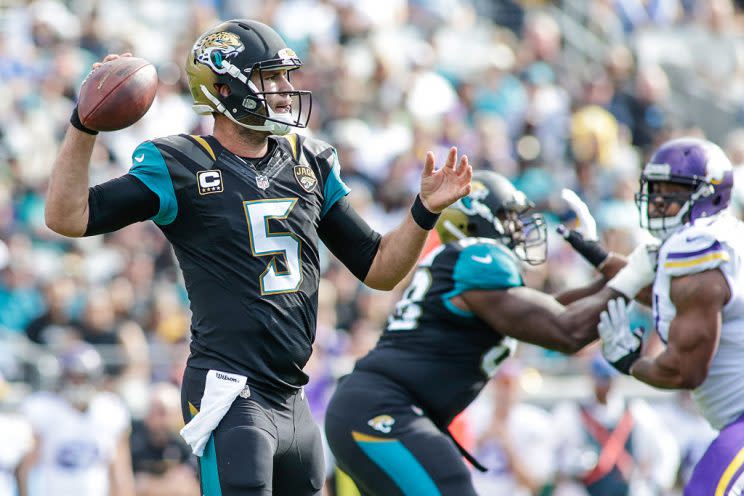Juggernaut Index, No. 23: Jaguars offer Fournette, A-Rob, so many interceptions

If you’re the sort of fantasy owner who avoids drafting players tied to terrible quarterbacks, then the Jacksonville Jaguars are really not for you.
[Fantasy Football is open! Sign up now]
Blake Bortles is a bad QB — perhaps irredeemably bad. This year, unlike the past two seasons, he is almost certainly not going to finish with 600-plus pass attempts, so his fantasy value won’t be propped up by extreme volume. Jaguars head coach Doug Marrone seems committed to minimizing the impact of his fourth-year QB:
Marrone wasn’t shy Friday when he told reporters how committed he is to the running game. He was asked how many passes he would like to see Bortles throw in a game.
“For me, I like to run the ball every play,” Marrone told reporters. “None. Zero. I want to go back to the old way.”
If any other passer were at the controls of Jacksonville’s offense, we’d consider Marrone’s stance to be ridiculously outdated. But with Bortles behind center, using a playbook straight from 1977 might be the team’s best hope.

Bortles has never finished a season with a completion percentage higher than 58.9. He’s averaged just 6.6 yards per attempt for his career, and he’s tossed at least 16 interceptions in each of the past three years. Even in his breakout fantasy season in 2015, he led the NFL in sacks (51), interceptions (18) and fumbles (14), claiming the triple crown of bad quarterback play.
So when Marrone says he’d like to avoid passing the football this season, you can believe him. General manager Dave Caldwell, the man who drafted Bortles, is on board with a dramatic reduction in passing volume, too. Bortles seems more likely to lose his job than finish as a top-10 fantasy QB in 2017. It’s clear this team has more confidence in its rookie running back than in its fourth-year quarterback.
Leonard Fournette will get all the work he can handle.
Fournette, not Bortles, is the centerpiece of this offense. If any player in the 2017 draft class is a foundational back, it’s him. Fournette has a linebacker’s build with excellent straight-line speed. He’s a violent runner, a nightmare for would-be tacklers in one-on-one situations. His LSU tape is of the highest quality, full of punishing collisions and beaten defenders. He averaged 147.2 rushing yards per game and 6.5 per carry over the past two collegiate seasons while facing a loaded schedule.
It’s reasonable to worry that Fournette’s preference for trucking defenders makes him at greater risk of injury, compared to the typical NFL starting back. Ankle issues limited him to just seven games and 129 carries last season. He also ran infrequently from shotgun in college, and with results that didn’t match his performance as an old school I-formation power runner. But after using the No. 4 overall pick on Fournette, the Jaguars presumably aren’t going to shoehorn him into formations and schemes in which he isn’t at his best.

The bottom line with Fournette is this: He enters the season as the team’s unchallenged early-down runner. He’s a potentially special player, in line for a massive workload. Offseason reports on his pass-catching ability have been promising, though he wasn’t heavily involved as a receiving threat at LSU. T.J Yeldon is an unexceptional third-down back, primarily useful in PPR leagues. Chris Ivory is simply depth. Fournette is the show. He has the clear potential to deliver top-of-draft fantasy value, and he’s available at a third-round price (32.9, RB13).
Allen Robinson, bounce-back candidate.
Again, we need to be mindful of the fact that Marrone has no interest in coaching a pass-first team that puts the ball in the air 600 times. He’s made that clear, as have Caldwell and executive VP Tom Coughlin. But that doesn’t mean Jacksonville’s best receiver can’t still produce a quality fantasy season — and that No. 1 receiver, to be clear, is definitely Robinson. He led this receiving corps in every meaningful category last season, including targets (151), receptions (73), yards (883) and touchdowns (6). He ranked third among all NFL receivers in targets inside the 10-yard line (11), nearly matching his total from the prior season (14).
Unfortunately, leading all Jaguars receivers in fantasy production was not a significant achievement in 2016. Robinson tied for seventh at his position in total targets last year, yet finished outside the top-30 in standard fantasy scoring. That ain’t easy. He’s one of only three players since 1992 to gain less than 900 receiving yards on 150 or more targets. (Larry Fitzgerald did it in 2012, when he was dealing with Kolb, Skelton and Lindley. Chris Chambers did it in 2006 because he was awful). Robinson zealots will note, however, that two of his best single-game yardage totals last year were produced in the two weeks that Marrone was coaching the team. This was likely not coincidental:
Jaguars interim HC Doug Marrone says team moved WR Allen Robinson around more in the offense Saturday than previously this season.
— John Oehser (@JohnOehser) December 26, 2016
Robinson remains a player with Dez Bryant-like size and skills, just one year removed from a 1400-yard, 14-touchdown season. He’s seen 40 red-zone targets over the past two seasons. Even in an increasingly run-focused offense, he can thrive. It’s not unreasonable to expect him to split the difference between his breakout 2015 and his mostly disastrous 2016. Expect 1100 receiving yards with 7-9 TDs and draft accordingly.
Marqise Lee nearly matched Robinson’s full-season production on only 105 targets, finishing with 63 catches for 851 yards and three spikes. He also managed to play all 16 games for the first time in his three NFL seasons. Lee appeared to leapfrog Allen Hurns in Jacksonville’s receiving hierarchy last year, outproducing him by a wide margin in November (16-223-2 for Lee, 4-34-1 for Hurns). A hamstring injury sidelined Hurns over the final five weeks, as he finished with career lows across the board: 35 catches, 76 targets, 477 yards, three TDs.
The Jaguars are no lock to produce more than one roster-worthy receiving threat for fantasy purposes this season, but Lee enters camp as the presumptive No. 2. He can serve as a low-level PPR contributor in deeper formats. Don’t expect anything more from Lee than last year’s stats, assuming good health. Jacksonville used a fourth-round draft pick on Dede Westbrook, an enormously productive collegiate receiver at Oklahoma (80-1524-17 in 2016). Westbrook missed much of the offseason program due to injury, so he enters camp well behind Lee and Hurns on the depth chart.
Julius Thomas was flipped to Miami back in February (for almost nothin’), leaving Jacksonville with a veteran tight end tandem of Marcedes Lewis and Mychal Rivera. None of the names in this paragraph should excite fantasy owners. Moving on…
Jacksonville’s defense is no joke.
The Jaguars ranked as the league’s sixth stingiest defense in terms of yards against (321.7 YPG) and fifth against the pass last season (215.3 YPG, 6.6 Y/A). But they generated only 13 takeaways and 33 sacks, so this group wasn’t a particularly high-scoring fantasy D/ST. It remains a strong unit, however, and the Jags added significant pieces in the offseason — notably CB A.J. Bouye, DL Calais Campbell and SS Barry Church. This team’s secondary also features Jalen Ramsey, an ascending talent who worked as a shadow corner in his rookie season. No one should be surprised if Jacksonville’s defense makes a significant fantasy leap this year. The team’s last-place schedule certainly won’t hurt. The Jaguars have matchups with the Jets, Rams and Browns, plus a visit to San Francisco in Week 16. Feel free to sleep on Jacksonville’s passing game, but not the D.
2016 Offensive Stats & Ranks
Points per game – 19.9 (25)
Pass YPG – 233.0 (20)
Rush YPG – 101.9 (22)
Yards per play – 5.1 (25)
Plays per game – 65.8 (8)
—
Previous Juggernaut Index entries: 32) NY Jets, 31) San Francisco, 30) Cleveland, 29) LA Rams, 28) Baltimore, 27) Chicago, 26) Minnesota, 25) Detroit, 24) Denver, 23) Jacksonville


